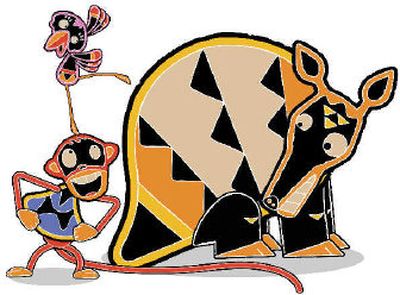‘Tickle U.’

The Cartoon Network is plenty popular with school-age children. Now it’s coming for the babies.
Starting today, the Atlanta-based network is airing a two-hour morning block of cartoons for preschoolers – even children under a year old.
Cartoon Network’s new “Tickle U.” block from 9 to 11 a.m. is aimed at improving the network’s ratings on weekday mornings, when it falls behind rivals like Nickelodeon and Disney Channel.
Before, Cartoon Network was relying on classic cartoons like “Tom & Jerry” for the hours when older kids are in school.
“Up until now, the focus has been, ‘What can we put on the air that mom or baby sitter remember fondly from their childhoods?’ ” said Alice Cahn, Cartoon Network’s vice president for programming and development. “I think there was recognition that there was an opportunity to do more.”
Cahn and other network executives also recognized that despite repeated warnings from child development experts, most parents allow babies and toddlers to watch TV.
Parents should be careful about plopping infants and toddlers in front of the set, said David Pelcovitz, a child psychology professor at Yeshiva University in New York.
“Their brains aren’t wired in a way they can understand what’s going on,” Pelcovitz said. “Parents should know it may risk attention problems for kids later on. It’s just not a good medium for them.”
The American Academy of Pediatrics recommends that children under 2 watch no television at all, but Cahn called that impractical. Television can be OK in small doses, she said.
“Children begin watching television – and I think this is a conservative estimate – as young as 12 months,” said Cahn, who worked on PBS’ “Sesame Street” before coming to Cartoon Network.
“No, you shouldn’t leave a preschooler in front of a television for five hours. But no sane person would do that.”
To make it more appropriate for young kids, the “Tickle U.” block contains no shows longer than 11 minutes (most are closer to five minutes long). Commercials are shown only on the half-hours, not between every cartoon.
And to encourage parents to watch along with their kids, the cartoons have what programmers call a “Mommy Bar” on the bottom of the screen with parenting tips and G-rated jokes for grown-ups.
Instead of trying to teach facts, like “Dora The Explorer” on Nickelodeon, the Cartoon Network shows are simply aimed at making kids laugh.
“You know they’re going to get the A-B-Cs and 1-2-3s in preschool,” said Pola Changon, Cartoon Network’s vice president for on-air production.
Instead, the “Tickle U.” cartoons are aimed at developing a sense of humor in young kids, which Cahn said is of more value than drilling facts into a toddler.
“We have all these increased ambitions for young kids. Are we pushing kids too far too fast?” she said.
“There’s almost a competitive nature of parenting, and we’re trying to work against that. If you’re holding flash cards in front of a 16-month-old, isn’t it better to hold up a sock puppet and play hide-and-seek?
“We want to be a safe and engaging – and funny – place for kids on TV.”